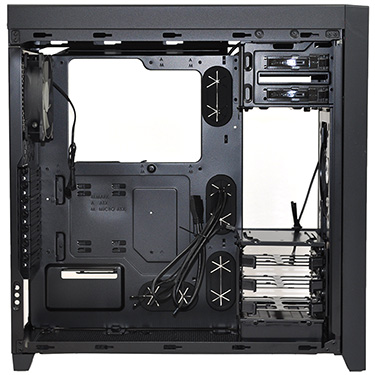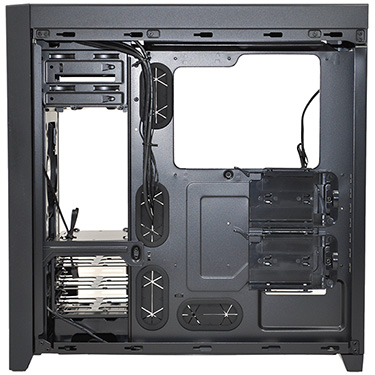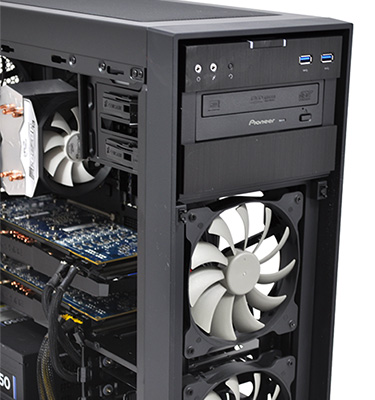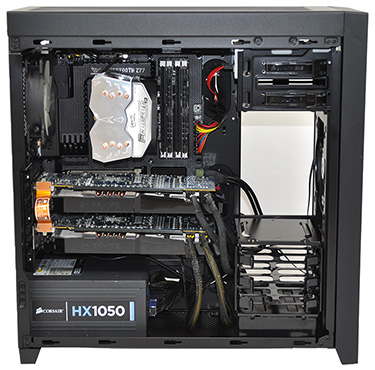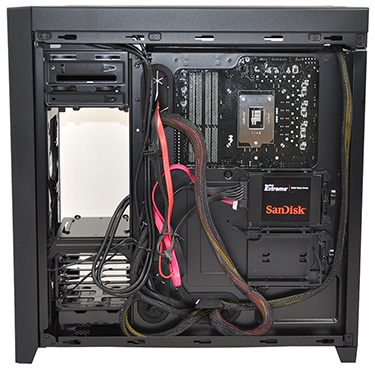Inside the Obsidian Series 450D
The nature of our work is such that we're frequently making our way in and out of chassis. That's the reason why we still employ Graphite Series 600Ts for our test platforms - they have quick-release panels that are oh so easy to use.
Unfortunately, both 450D side panels are of the notched, thumb-screwed variety, meaning they aren't as easy to attach as they might have been. We might be nitpicking, but it always feel like a chore having to align notched panels, and we'd have preferred a hinged design. Or, better yet, the convenient quick-release panels that worked so well on the 650D.
Are the side panels a deal breaker? Well, that depends entirely on how often you venture inside the chassis. For most users, we suspect this won't be a problem, and once you're in, you can generally look forward to a trouble-free build.
As you'd expect, Corsair's layout is logical throughout and plenty of provisions have been made for a high-end ATX build. At the core of the high-airflow proposition are three bundled fans: dual 140mm front intakes and a rear 120mm exhaust.
The default configuration is good, but it's the 450D's scope for improvement that will attract enthusiast users. There are eight fan locations in total, including three 120mm or two 140mm mounts up top and a further two 120mm mounts at the bottom.
This implies plenty of room for liquid-cooled radiators, with Corsair no doubt having its own Hydro Series in mind. You could, if you so wanted, install a 280/360mm radiator up top, along with a 240/280mm radiator up front, and you'd still have the rear and bottom fan mounts to play with.
Cooling potential is bountiful, and there's a decent mix of storage bays, too. Three hard disk trays are included as standard in a removable cage, along with twin 5.25in optical bays and a pair of 2.5in SSD mounts attached to the rear of the motherboard tray.
All seven bays are designed to be entirely tool free, and though they're built primarily from plastic, they work well enough. The only real snag is the implementation of the optical bays - they still look awkward when a drive is installed, and it's a shame Corsair hasn't found a better solution to this problem. The same issue exists on other recent Obsidian Series enclosures and modders are having to create their own workarounds.
Elsewhere, there's a big internal gap between the optical and hard-disk cages, giving the front intakes a nice, clear path, and we hear Corsair will be selling optional drive cages that will fill this void for the few users who need to run more than three HDDs.
Installing high-end components is no bother. The 450D supports full-size ATX PSUs, graphics cards measuring up to 430mm in length and CPU coolers standing up to 165mm tall. Our Intel Z77 test platform, with dual Radeon HD 7950 OC graphics cards, went in without a hitch, and though there are only the four rubber-grommeted holes, cable routing wasn't a problem. Getting the eight-pin CPU power connector to the top of board was particularly easy, with Corsair leaving a good-sized gap above the motherboard tray.
Getting hardware installed is simple enough, however there is a distinct lack of cable tie-down points. This makes it slightly harder to maintain tidiness around back, and you will want to keep clutter down to a minimum as the 20mm space behind the motherboard tray doesn't feel that generous when you're trying to align and re-attach the side panel.
Lastly, it's interesting to see how much space is taken up by the traditional storage column. If optical drives and hard-disks are becoming redundant, could Corsair remove this entire column and rely solely on rear-mounted 2.5in bays? Perhaps, and in doing so, future chassis could be made smaller and cheaper.






